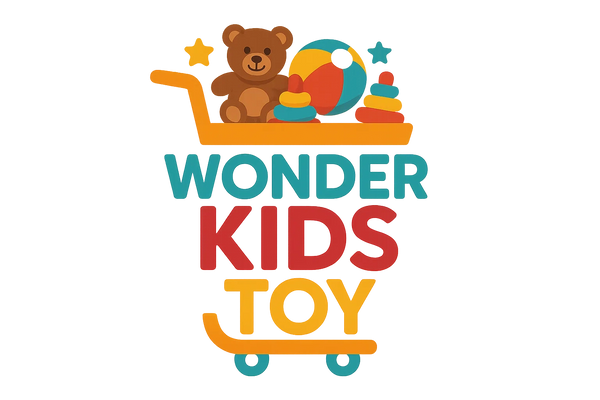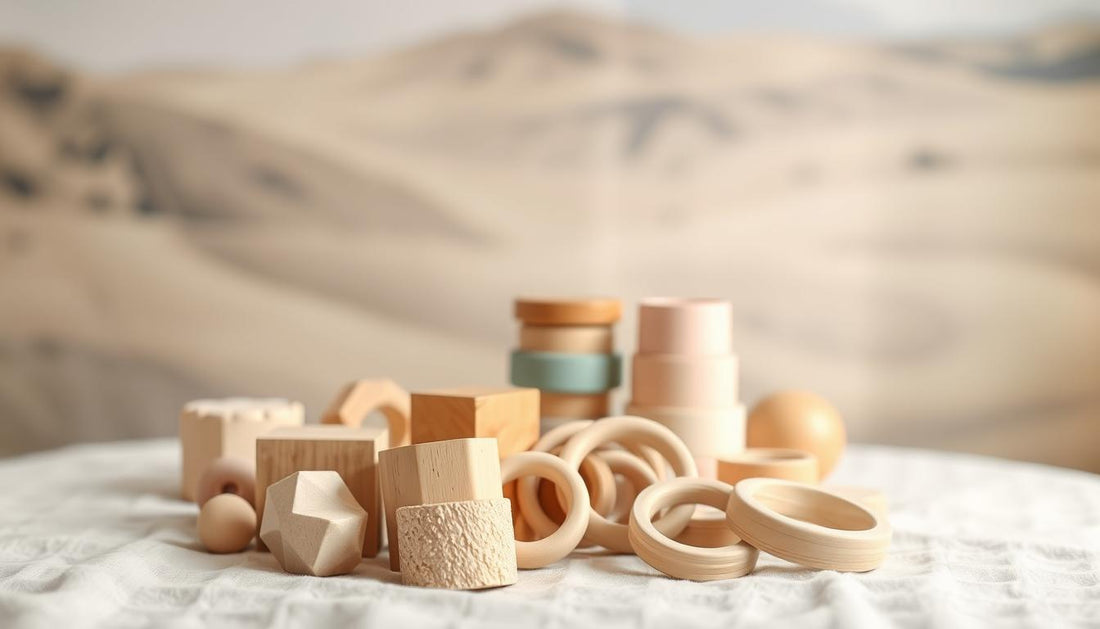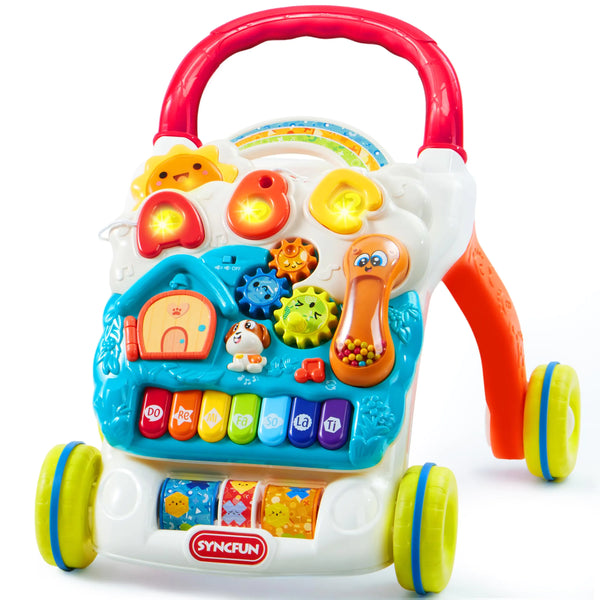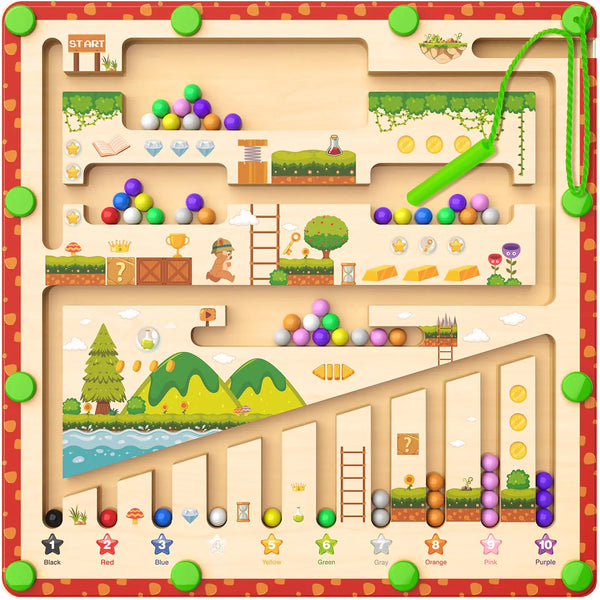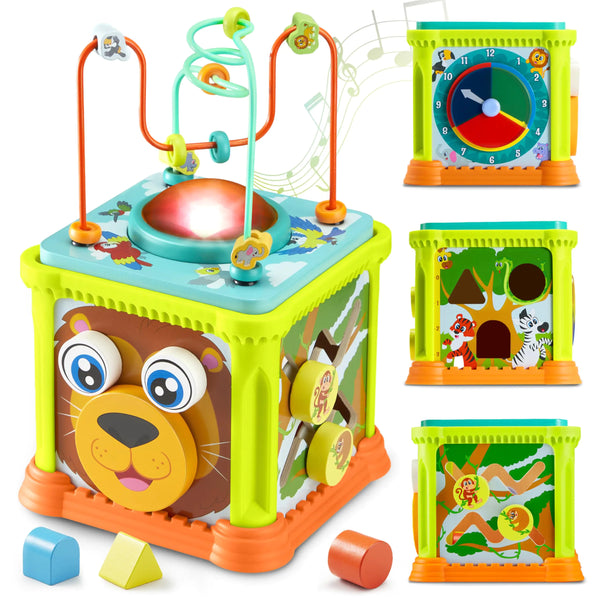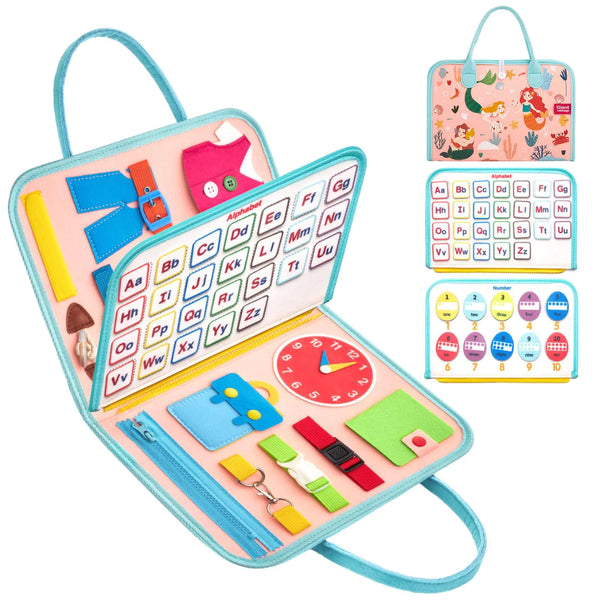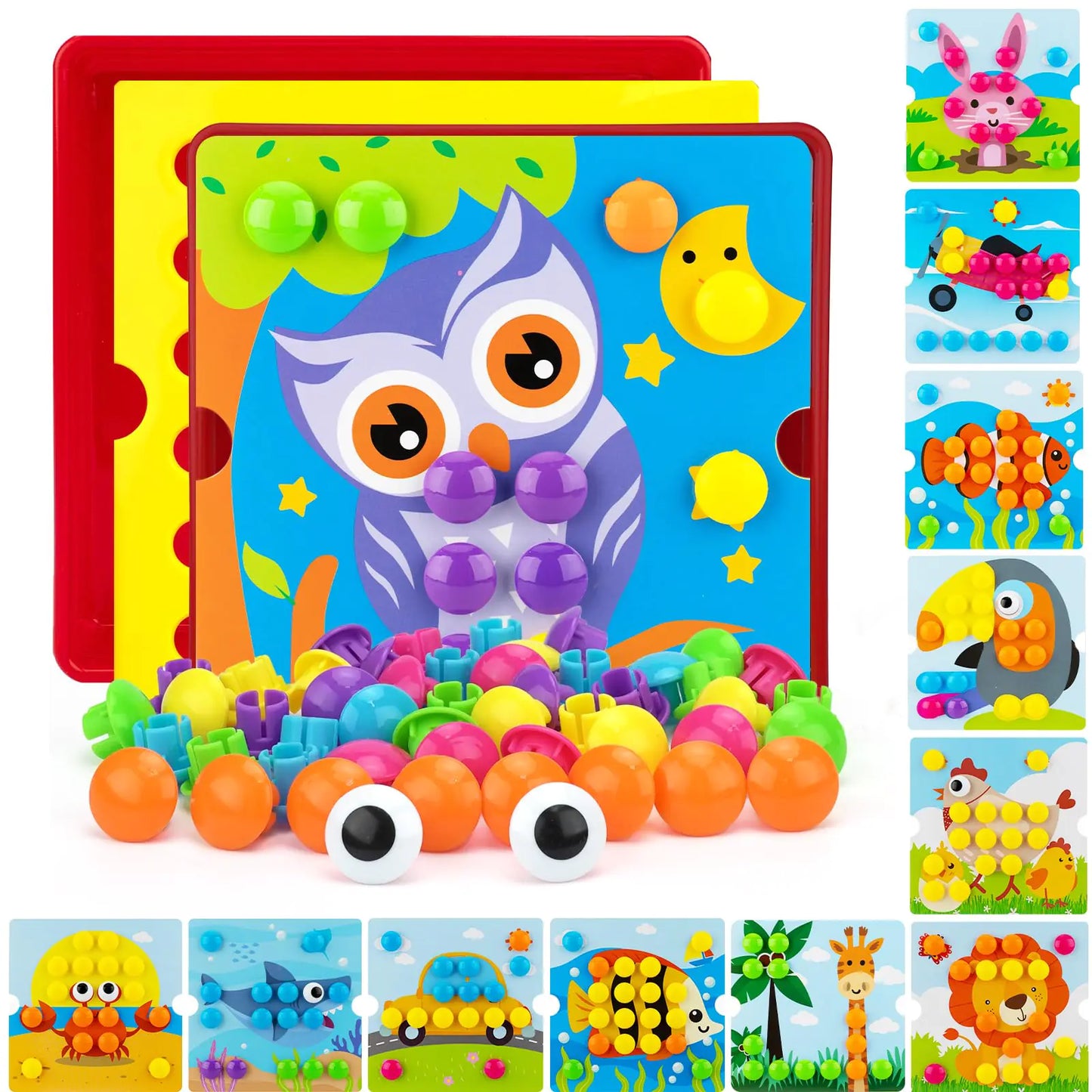Choosing the right toys for your baby can be tough. I've selected Montessori-inspired toys that support cognitive and motor skill development.
The Montessori method emphasizes learning through hands-on activities and collaborative play. By selecting toys that align with this approach, you can enhance your child's problem-solving skills and independence.
Key Takeaways
- Understanding the Montessori approach to child development
- Selecting toys that support cognitive and motor skills
- Choosing age-appropriate toys for your child
- Encouraging self-directed learning and hands-on activity
- Fostering independence and problem-solving skills
The Montessori Approach to Baby Development
The Montessori method is distinctive for its emphasis on independence and exploration. It's a child-centered approach to learning that encourages self-directed activities. This approach creates a prepared environment that sparks a child's curiosity.
Core Principles of Montessori for Infants
The Montessori method for infants is based on key principles. Independence is promoted early on through toys and activities that allow babies to learn at their own pace. Observation is also important, as it helps parents and caregivers tailor the environment to the child's interests and needs. The use of natural materials and simple designs creates an environment that is both clutter-free and stimulating.
| Principle | Description | Benefit |
|---|---|---|
| Independence | Allowing babies to explore and learn at their own pace | Fosters self-confidence and self-directed learning |
| Observation | Adapting the environment based on the child's interests | Enhances engagement and learning |
| Natural Materials | Using materials like wood and cotton | Provides a tactile and sensory experience |
How Montessori Differs from Conventional Baby Toys
Montessori toys are different from regular baby toys. While traditional toys aim to entertain, Montessori toys focus on learning and development. They are crafted from natural materials and have a
Choosing Montessori toys helps babies build a strong foundation for future learning. It also fosters a lifelong love of learning.
Why I Recommend Montessori Toys for Babies
The world of baby toys can be overwhelming. But Montessori toys are special. They help babies grow into independent and innovative individuals.
I love the Montessori method because it emphasizes learning through hands-on experiences. Montessori toys allow babies to learn through exploration and discovery.
Benefits for Brain Development
Montessori toys help babies' brains develop by allowing them to explore their world through play. For example, visual mobiles and sensory toys enhance cognitive development and fine motor skills.
With Montessori toys, babies get better at solving problems. They learn how things work together. This is great for their brains later on.
Fostering Independence from the Start
The Montessori method focuses on teaching babies to be independent from an early age. Montessori toys are designed for easy use by babies. They allow babies to learn and play independently.
By allowing babies to choose and play independently, Montessori toys help build their confidence, a key factor in their lifelong learning and growth.
Key Features of Quality Montessori Baby Toys
In Montessori, toys are more than just playthings; they are educational tools. They are tools designed to help babies learn and grow. When picking Montessori baby toys, look for certain qualities. These ensure they meet the high standards of the Montessori method.
Natural Materials and Their Importance
Quality Montessori toys often use natural materials. Wood, cotton, and wool are favorites because they are eco-friendly, long-lasting, and offer a unique feel. These materials also make a rich sensory environment, vital for a baby's growth.
| Material | Benefits |
|---|---|
| Wood | Durable, sustainable, and aesthetically pleasing |
| Cotton | Soft, breathable, and gentle on skin |
| Wool | Warm, natural, and provides excellent texture variety |
Simplicity in Design
Montessori toys are known for their simple designs. This simplicity is not just for looks. It's a choice to help the child focus on the toy's purpose. Simple designs also spark creativity and imagination, as they invite the child to interpret and engage.
"The greatest sign of success for a teacher is to be able to say, 'The children are now working as if I did not exist.'" - Maria Montessori
This quote shows the heart of Montessori education. It highlights how toys should help kids learn and explore on their own.
Safety First: Choosing Age-Appropriate Montessori Toys
When selecting Montessori toys for your baby, safety should be your top priority. As a parent, it's key to find toys that help your child learn and are safe. They should meet high safety standards.
Material Safety Considerations
Montessori toys are made from natural materials. It's essential to check the materials of a toy. Choose toys made from natural, non-toxic materials like wood, cotton, or wool. These are safer for your child and better for the planet.
Avoid toys with small detachable parts that pose a choking hazard. Always check if the toy has been recalled. Make sure it meets today's safety standards.
Size and Choking Hazard Prevention
The size of a toy is also a significant safety factor. Toys that are too small can be a choking hazard. Therefore, select toys that are suitable for your child's age. Montessori toys are designed for children to use independently, but they must be safe for them to handle alone.
| Age Group | Minimum Toy Size | Safety Consideration |
|---|---|---|
| 0-6 months | Larger than 1.5 inches | No small parts |
| 6-12 months | Larger than 1 inch | Avoid sharp edges |
| 1-2 years | Larger than 0.5 inches | Durable construction |
By keeping these safety tips in mind, you can make a safe space for your child to learn and play with Montessori toys.
Essential Montessori Toys for 0-3 Months
For newborns, the right Montessori toys are key for their growth. In the first three months, babies learn about the world through their senses. Montessori toys help them in a gentle, effective way.
Visual Mobiles and Their Benefits
Visual mobiles are vital for newborns. They help babies see and track objects more clearly. These mobiles feature high-contrast colors and simple shapes, making them ideal for young eyes.
Tactile Exploration Tools
Tactile toys are also important for newborns. They offer different textures and sensations. This helps babies feel and explore. Examples include soft fabrics, wooden toys, and rattles with varied surfaces.
My Top Recommendations for Newborns
Based on Montessori principles, my top picks for newborns include the Gorgeous Black and White Mobile, which supports visual development. Soft, fabric books are great for touch. Here's a summary of recommended toys in a tabular format:
| Toy Type | Benefits | Examples |
|---|---|---|
| Visual Mobiles | Stimulate vision, encourage tracking, and focusing | Gorgeous Black and White Mobile |
| Tactile Toys | Develop a sense of touch, explore different textures | Soft fabric books, wooden rattles |
Choosing the right Montessori toy sets a strong foundation for newborns' future growth.
Beyond Rattles: Essential Montessori Baby Toys for Cognitive and Motor Skills
Babies grow fast, and they need toys that do more than entertain. Toys that aid in thinking and movement are key. At this age, babies love to explore and learn.
Montessori toys are unique because they facilitate and support babies' self-directed learning. They're made from natural stuff and are simple. This helps babies focus and learn better.
Toys That Develop Hand-Eye Coordination
Hand-eye coordination is essential for babies. Montessori toys, such as hanging objects or mobiles featuring shapes and colors, are beneficial. For example, a toy that moves and requires you to catch it improves hand-eye coordination skills.
Here are some good toys:
- Rainbow-colored mobiles
- Hanging wooden shapes
- Soft, textured balls
Objects That Encourage Cause and Effect Learning
Learning about cause and effect is vital for babies. Toys that react to a baby's touch, like making sounds, teach them about cause and effect. These include toys with different textures and sounds.
Some examples are:
- Sensory bottles with beads or rice
- Musical instruments for babies
- Toys that sound when moved or touched
By using these Montessori baby toys, parents can provide their babies with a great start in learning and development.
Montessori Toys for 4-6 Month Babies
Babies from 4 to 6 months grow curious and start exploring their world. They use touch, sight, and sound to learn. It's essential to give them the right toys at this time.
Montessori toys for this age group support sensory experiences and the development of motor skills. The right toys can significantly aid a baby in learning and understanding their world.
Grasping and Reaching Toys
Between 4 and 6 months, babies start to grasp and reach. Montessori toys that help with these skills include:
- Rattles with easy-to-grasp handles
- Soft blocks or toys with different textures
- Toys attached to a string or elastic for reaching practice
First Sound Exploration Tools
At this age, babies start to explore sounds. Montessori toys that introduce sound include:
- Musical instruments designed for infants, like soft xylophones
- Rattles that produce different sounds when moved
- Sound-making toys that encourage cause-and-effect understanding
Best Sellers I've Tested with My Baby
Some top Montessori toys for 4- to 6-month-old babies I've tested are:
- The Grimm's wooden rattle, known for its high-quality craftsmanship
- The Hape Pound & Tap Bench with Slide Out Xylophone, which combines music with motor skill development
- The PlanToys Sensory Rattle Set, with a variety of sounds and textures
These toys are fun and educational for my baby. They help with healthy growth and curiosity.
Supporting Sitting and Crawling: Toys for 7-9 Months
Babies at 7-9 months start sitting and crawling. The right toys help a lot with this. They also help babies learn and grow as they explore.

Movement Encouragement Toys
Movement toys are key at this age. Push-pull toys are great for crawling and walking. They come in shapes like toy carts or animals on wheels.
These toys make babies want to move towards them. This helps build their muscles and improves their movement.
Object Permanence Boxes and Balls
Learning about object permanence is big. Toys like object permanence boxes and rolling balls help with this. They teach babies that things keep existing even when they can't see them.
This helps babies solve problems better.
Practical Toys for This Critical Movement Stage
Practical toys are essential at this time. They can be held, moved, and explored. Soft blocks and textured balls are great for little hands.
These toys help develop fine motor skills and provide babies with a fun way to learn and explore. They also aid in sensory development, which is crucial for overall growth and development.
Montessori Toys for 10-12 Month Developmental Leaps
Babies near their first birthday undergo significant physical and mental changes. The right Montessori toys can make a substantial difference. They make babies more curious and help with thinking and moving skills.
Stacking and Nesting Toys
Stacking and nesting toys are great for little hands and eyes. They come in many shapes and sizes. This helps babies learn about things being there even when they can't see them.
I suggest wooden blocks or cups. They are strong and easy to clean.
Simple Puzzles and Problem-Solving Tools
Simple puzzles and problem-solving toys are excellent for developing thinking skills. They help babies learn to solve problems. Look for puzzles with big, manageable pieces. Please make sure they are safe and made from non-toxic materials.
Language Development Toys
Learning to talk is very important at this age. Montessori toys that aid in language development include labeling toys and alphabet puzzles. These toys help babies connect words with objects, which is key for developing their language skills later.
| Toy Type | Developmental Benefit | Recommended Age |
|---|---|---|
| Stacking Toys | Fine Motor Skills, Hand-Eye Coordination | 10-12 Months |
| Simple Puzzles | Cognitive Development, Problem-Solving | 10-12 Months |
| Language Development Toys | Language Skills, Vocabulary Building | 10-12 Months |
Toys That Specifically Target Cognitive Development
Cognitive development is key in a child's early years. The right toys can really help. Montessori toys, in particular, are designed to enhance cognitive skills through engaging and challenging play.
These toys aim to enhance cognitive development by encouraging children to explore and learn, focusing on two primary areas: pattern recognition and understanding cause and effect.
Pattern Recognition and Memory
Montessori toys that aid in pattern recognition and memory development are excellent for children. They include:
- Object sorting toys challenge kids to sort objects by shape, color, or size.
- Memory games with cards or objects that require kids to recall patterns or sequences.
| Toy Type | Cognitive Benefit |
|---|---|
| Object Sorting Toys | Enhances pattern recognition and problem-solving skills |
| Memory Games | Improves memory and concentration |
Cause and Effect Understanding
Toys that demonstrate cause and effect help children understand how their actions impact the world around them. Examples are:
- Rattles or musical instruments that make sound when kids play with them.
- Puzzle toys that kids must solve to get a particular result.
Playing with these toys helps kids understand the world better. It also boosts their cognitive skills.
Montessori Toys for Fine and Gross Motor Skill Development
As a parent, I've seen how Montessori toys enhance motor skills. These skills are crucial for a child's growth, allowing them to interact with their world. Montessori toys develop both fine and gross motor skills, laying a strong foundation for physical abilities later on.
Pincer Grip Development Tools
Toys that help with the pincer grip are vital for fine motor skills. Some great tools include:
- Small object sorting toys that challenge kids to pick and sort different objects.
- Pincer grip exercisers that make the muscles for the pincer grip firmer.
- Object retrieval games that teach kids to use their thumb and forefinger to pick up things.
Whole Body Movement Toys
Gross motor skills utilize larger muscles and involve actions such as crawling, walking, and running. Montessori toys that encourage whole body movement include:
- Tunnels and tents for crawling and exploring.
- Balance beams for better coordination and balance.
- Push-pull toys for stronger legs and more movement.
By incorporating Montessori toys into playtime, parents can help their child develop their fine and gross motor skills. This enhances kids' confidence and physical abilities.
Creating a Montessori-Friendly Play Space at Home
A Montessori-friendly play space is more than a place to play. It's a place where learning and growth happen. As a parent, you can create a space that sparks your baby's curiosity and fosters a love for learning.
"The environment is the third teacher," as Maria Montessori said. This illustrates the significant impact of surroundings on a child's learning. By designing your home well, you can help your baby grow and develop.
Setting Up Accessible Toy Shelves
Having accessible storage is key in a Montessori-friendly play space. Use low shelves or storage that your baby can reach easily. Labeling these with pictures or words helps your baby learn to find and sort toys.

Rotating Toys to Maintain Interest
Rotating toys keeps your baby interested. Changing the toys around prevents boredom and sparks curiosity. It also allows you to see what your baby likes so that you can tailor the space to their preferences.
To do this, keep some toys hidden and switch them out every few weeks. This makes the toys seem new and exciting, encouraging your baby to explore and learn.
DIY Montessori Baby Toys You Can Make at Home
Creating your own Montessori toys is a fun way to support your baby's growth. It's also beneficial for your wallet and allows you to create toys that cater to your baby's specific needs.
Simple Sensory Bottles
Creating sensory bottles is a breeze and keeps your baby engaged. Just fill a plastic bottle with water, oil, or sand. Add some food coloring, glitter, or small toys for fun. Shake the bottle gently to create a mesmerizing effect.
Homemade Treasure Baskets
Treasure baskets are perfect for learning and fun. Place natural items, such as pinecones, shells, and wooden shapes, in a basket. Supervise your baby as they touch and learn about different textures.
No-Sew Sensory Materials
You can easily create no-sew sensory materials, such as bags or mats, with these instructions. Fill a cloth bag with rice, beans, or sand and add small toys. Let your baby explore the textures and sensations.
How to Introduce Montessori Toys to Your Baby
Introducing Montessori toys to my baby has made playtime more enjoyable and contributed to their growth. It's not just about the toys; how you introduce them is crucial.
Every baby is different, and what works for one might not work for another. Observation is key. By watching your baby's interests and skills, you can pick the best Montessori toys for them.
Observation and Following the Child's Lead
Observation means watching your baby's likes, skills, and how they play. This helps you follow their lead and choose toys that match their stage. For example, if they love touching things, toys with different textures can be exciting.
| Age | Montessori Toy | Developmental Focus |
|---|---|---|
| 0-3 Months | Visual Mobiles | Visual Development |
| 4-6 Months | Grasping Toys | Motor Skills |
| 7-9 Months | Object Permanence Boxes | Cognitive Development |
Demonstrating Without Interfering
After selecting a suitable Montessori toy, it's time to introduce it to your baby. Show them how to use it once, then let them try it on their own. This way, you help them learn without doing it for them.
By thoughtfully introducing Montessori toys, you enhance playtime and support your baby's development. This method fosters independence, curiosity, and a lifelong love of learning.
Budget-Friendly Montessori Toy Options
You don't have to spend a lot to give your child great Montessori toys. Many people think Montessori toys are pricey. But, many affordable choices are just as good.
Affordable Brands That Don't Compromise Quality
Many brands offer top-notch Montessori toys at prices that won't empty your wallet. Some of these brands include:
- Grimm's: Known for their wooden toys that are both durable and aesthetically pleasing.
- Oeuf: Offers a range of eco-friendly toys that are perfect for Montessori play.
- PlanToys: Creates toys from sustainable rubberwood, promoting environmental responsibility.
These brands aim to provide you with high-quality Montessori toys at an affordable cost.
Everyday Household Items as Montessori Toys
Using everyday items is a super budget-friendly way to get Montessori toys. Here are some ideas:
- Kitchen utensils, such as wooden spoons and metal colanders, can become fascinating toys.
- Cardboard boxes: Ideal for fostering creativity and developing problem-solving skills.
- Natural materials: Items like pinecones, leaves, and rocks can be used for sensory exploration.
By utilizing these items, you can create a rich Montessori environment without incurring significant expenses.
Nurturing Your Baby's Development Through Montessori Play
Montessori baby toys offer numerous benefits for a baby's development. They help with thinking and moving skills. By adding Montessori play to daily life, parents support their baby's development.
I've shown you Montessori toys and activities for babies from 0 to 12 months. These toys help develop independence, hand-eye coordination, and problem-solving skills. The right toys create a supportive space for your baby's growth.
Montessori play is more than play. It's a way to help your baby grow and succeed. By incorporating Montessori principles into play, parents provide their baby with a great start. I encourage you to explore Montessori play and see how it benefits your baby's development.
FAQ
What are the best Montessori baby toys for cognitive development?
The top Montessori toys for brain development include visual mobiles and tactile tools. They also have boxes and balls that teach about patterns, memory, and cause and effect.
How do I choose the right Montessori toys for my baby's age?
Pick toys that match your baby's age and needs. For 4-6 months, select toys that aid in grasping. For 10-12 months, go for stacking and nesting toys.
Are Montessori toys safe for my baby?
Yes, Montessori toys are made with safety in mind. They use natural materials and simple designs. Always check the toy's safety and size to ensure they are suitable for your baby's age.
Can I make Montessori toys at home?
You can make Montessori toys at home. Try making sensory bottles, treasure baskets, and no-sew sensory materials. It's fun and saves money.
How do I introduce Montessori toys to my baby?
Start by watching your baby's interests. Then, show them the toy without taking over. Let them explore and learn at their own pace.
Are Montessori toys expensive?
No, Montessori toys don't have to be expensive. Look for affordable brands or use items you already have at home. It's a budget-friendly option.
How often should I rotate Montessori toys?
Replace toys every few weeks to keep your baby engaged and interested. This helps prevent boredom and keeps play exciting.
What are the benefits of Montessori play for my baby's motor skill development?
Montessori play boosts motor skills in many ways. It includes tools for pincer grip and toys that encourage whole-body movement. These help improve both fine and gross motor skills.

